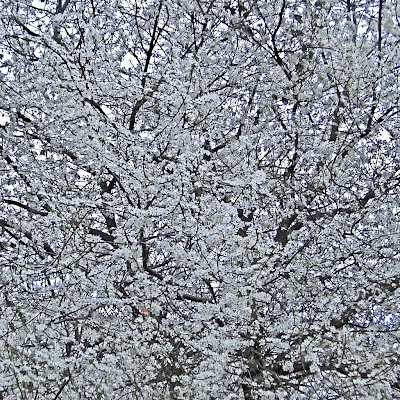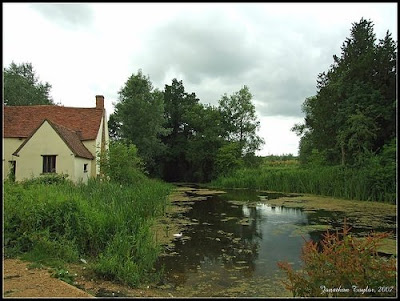Of what? Of cherry plums. What are they then?
The simple answer is they are plums that look like cherries and the trees can be found planted in many a street and garden mostly across the southern half of the country.
But you want to know more than that don’t you? Well then if you are sitting comfortably I shall begin.
© Danielle Harlow – Fotolia.com
We’ve lived in our house for nearly 12 years and when we arrived the garden was a bit ramshackle. It had been nice at one point I’m sure but the previous owner was rather old (he had lived his whole life in the house) and it had been left to get overgrown. Both garden and house were in need of a LOT of work. It was a great chance to start from scratch and not have to live with someone else’s idea of the ‘perfect’ terraced house. So we set to work. It took the best part of 8 years for the house to be completely finished and a bit like the Forth Bridge it’s now time to start decorating all over again (no walls to re-plaster though this time).
But I digress.
We have also made plenty of changes to the garden. Sadly the greenhouse hidden at the end was too rotten to save and the pond a little too large to look after. So they went. There were plants that were past their prime or couldn’t survive the severe trim they needed and others we didn’t know what to do with (or didn’t like – pampas grass anyone!). One of these was a quite young looking tree that didn’t show much promise; it was bolting for the light through the trees in our neighbours’ garden. The initial decision was that it would probably have to go. But we didn’t get round to it and then it was February and the tree came into blossom way before anything else giving a wonderful feeling of the approaching spring and providing some brightness in a wintery garden.

The tree in blossom earlier this year
So it stayed. And each year the blossom has been wonderful, sometimes as early as January but never later than the end of February. The blossom is white and because it comes so early I started to assume maybe it was some kind of almond tree.Then we started to get fruit, not many at first and often hard and green with a small stone. It didn’t really look like an almond and I never got very far in trying to find out what it was.
Plums on the tree in mid June
Then this year I became determined to find out what it was. I was spurred on by my day of wild food foraging but it wasn’t until I got a copy of The Forager Handbook (thanks @RachieGraham) that I was finally able to work out what it was. Some cross checking on the internet to confirm and just as the fruits started to be ready I knew at last that it is a cherry plum and that it is edible. And this year there seemed to be quite a lot of fruit.
Just some of the haul
So I started to collect the fruit, and I carried on collecting them, and on and on and on and on and on. And over about 3 days I collected about 15kg (I lost count somewhere I think). And then I needed to process them because eating 15kg of fruit straight off was not going to be a good idea. A couple of tweets later and I had recipes for pickled plums (thanks to @Weezos) and plum chutney (thanks to @TheAmpleCook) and some possible giveaways that in the end couldn’t be managed. Naturally I already had in mind some of my almost legendary fruit vodka so I got to work. Oh my and what work it was.
Bucolic England (Flatford Mill, 2007. copyright Jonathan Taylor (Flickr user Northstander)
When I was a ‘corporate slave’ I harboured dreams of having a little chutney and preserves business, because when you sit at a desk most of the day building spreadsheet models, writing reports and trying to keep 150 very nice solicitors in check your mind roams off into bucolic styled dreams of country England and domestic pursuits such as baking bread and making chutneys. Every now and then I would rustle up a batch of some kind of chutney and dish it out to delighted friends and family – it all seemed such fun. Well let me tell you its not so much fun if you have to do it day in day out. And I say that after only 2 ½ days of plum processing! I reckon that each kilo of plums equated to about 180 actual plums.
Just some of the 2700 plums I stoned
So I’ve stoned 2,700 plums BY HAND. I’m surprised I haven’t developed RSI. And the thing is I reckon I only got about ¼ of the total possible harvest…why? Well the tree is against our fence so half of the branches are over next-door’s garden so there’s 50% I didn’t get and then I was only collecting those that fell and were in good condition and weren’t under a prickly shrub. I took a peak under one of the shrubs and there were loads more under there so I reckon I lost another 25% that way (of the total not of the remainder – see what all those years with spreadsheets did to me). So I guess the tree had roughly 60kg of fruit on – not bad for what used to be a gangly upstart that we nearly got rid of.
Now I have pickled plums, plum chutney, plum vodka, plum compote, bottled plums (in sweet syrup) and I’m still collecting about 500g a day……more vodka with them I think as that’s the easiest to make.

Here’s the final haul
So if you’ve got a plum or damson tree watch out because I think it’s going to be a bumper summer. And if you’ve not well then don’t go too mad at the fruit farm 2½ days of fruit processing is more than enough for anyone.
I don’t use fixed measure for this but ratios.
Select your fruit of choice and weigh it. They tip it in a large glass jar (e.g. a preserving jar with a clip lid).
Add between half to the same weight of sugar (I usually used granulated) depending on how tart the fruit is and how sweet you want the result to be.
Then pour over about 1 ¼ -1 ½ times the volume of vodka as you had weight of fruit; so if you had a 750ml bottle of vodka you’d be looking to find between 500-600g of fruit.
Add any extras you think you’d like, a shaving of lemon peel is good with damsons or sloes.
Stir it all round to get as much as the sugar to dissolve as possible.
Close the jar and leave for a minimum of 6 weeks.
Check regularly and shake to help the sugar dissolve. After the first 6 weeks test the flavour and either leave to extract more flavour or strain and bottle.
Leave the bottle to mature for a further few months minimum. It gets better with age if you can resist for long enough.
Tips:
- If you haven’t got a large glass jar but have a glut of fruit you need to use up quickly then put everything a big non-reactive pan, cover and then track down a jar – it’ll be fine for the first few weeks in a pan.
- You can use gin instead of vodka but remember gin already contains its own aromatics so you’ll get a different flavour. Sloes and damsons work particularly well with gin.
- If the fruit is quite hard then you need to break the skin to allow the flavours to mix – I do this by putting the fruit in a large freezer bag and bashing it a bit with the rolling pin. If you’ve stoned the fruit (or its a soft fruit) then there’s no need to do this.
- You might want to strain through muslin or even a coffee filter before bottling if you want a really clear result. If you don’t mind sediment there’s no need to bother.
- Be wise whom you share the vodka with; once people have tried some they’ll always be angling for another bottle.
Plum Pickle (adapted from a series of Tweets by Weezos)
1kg plums
1ltr wine vinegar
500g sugar
100g salt
spices of your choice
Salting the plums
Stone the plums and place them in bowl sprinkling salt over each layer as you go. Leave for 12-24 hours.
Sterilise glass jars in an oven for 10 minutes at R2/150C and leave to cool.
Bring the vinegar, sugar and spices to the boil and simmer for 5 minutes. Allow to cool.
Rinse the salt from the plums and pack in jars. Cover with pickling vinegar.
Seal and allow to mature for a minimum of two weeks (longer is better) in a cool place.
Good with terrines and game dishes.
Spiced Plum Chutney (thanks to TheAmpleCook)

Nearly ready for the jars
This recipe is from Delia Smith.
3lb plums
1lb apples
3 onions
3 cloves garlic
2 heaped tsp ginger
1lb seedless raisins
1lb soft dark sugar
1lb Demerara sugar
1 pint vinegar (recipe says malt I used cider)
2 tbsp salt
2 cinnamon sticks
1oz allspice berries
1 dsp whole cloves
large non-reactive pan
6 jars
Note: you can adapt the spices to a mix of your favourites but you need roughly the same quantity, for example I had a smoked chilli in mine, and coriander because I like them.
Put the spices in a muslin square and tie it tightly with string.
Stone the plums, finely chop the apples (cored but leave on the skins), finely chop the onions and put them all in a large pan.
Crush the garlic and add it, the raisins, ginger, sugars and vinegar to the pan. Sprinkle in the salt and stir well.
Suspend the whole spices in their ‘bag’ into the pan and tie to the handle for easy removal later.
Bring to the boil and then simmer pour about 3 hours until the vinegar has almost disappeared and you have a thick, soft chutney. Remember to stir occasionally to prevent sticking.
Sterilise the jars and fill whilst both they and the chutney are still warm.
Leave to mature in a cool place for a minimum of 3 months.

